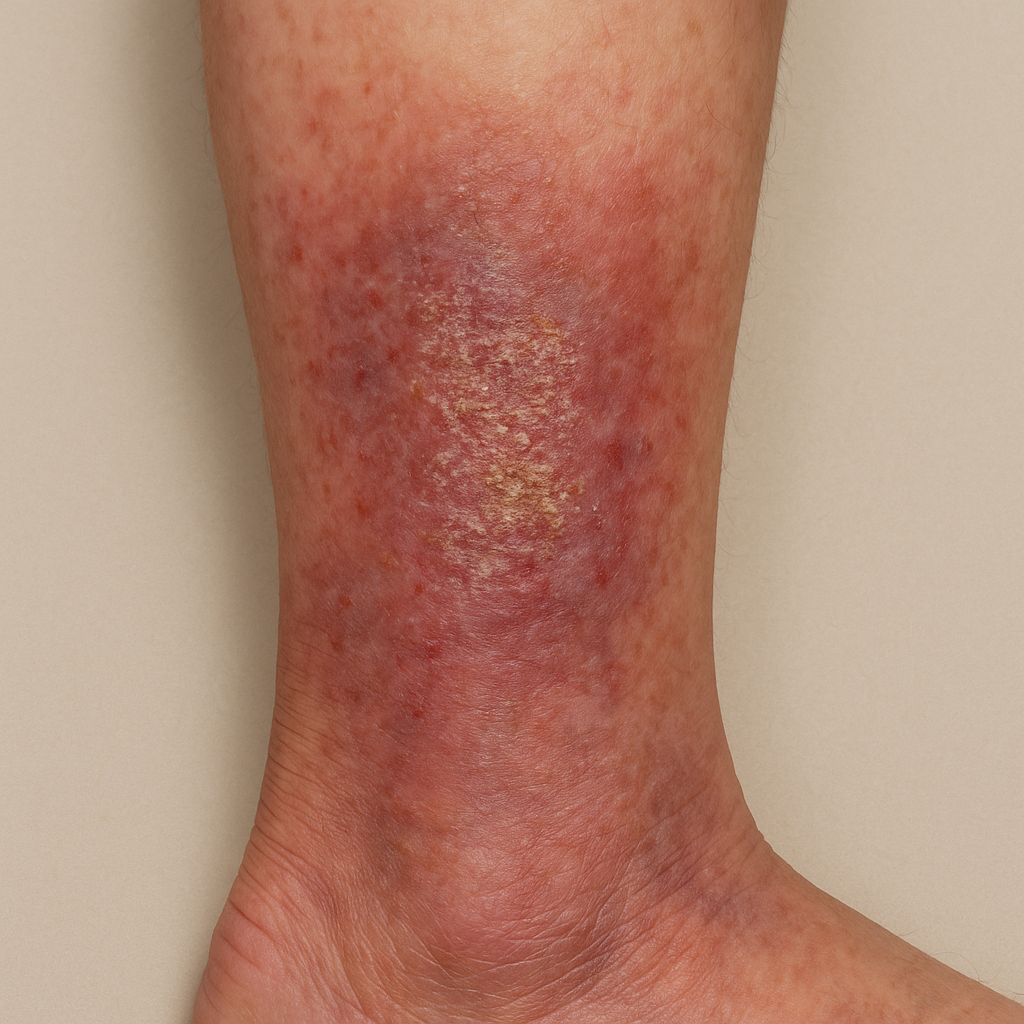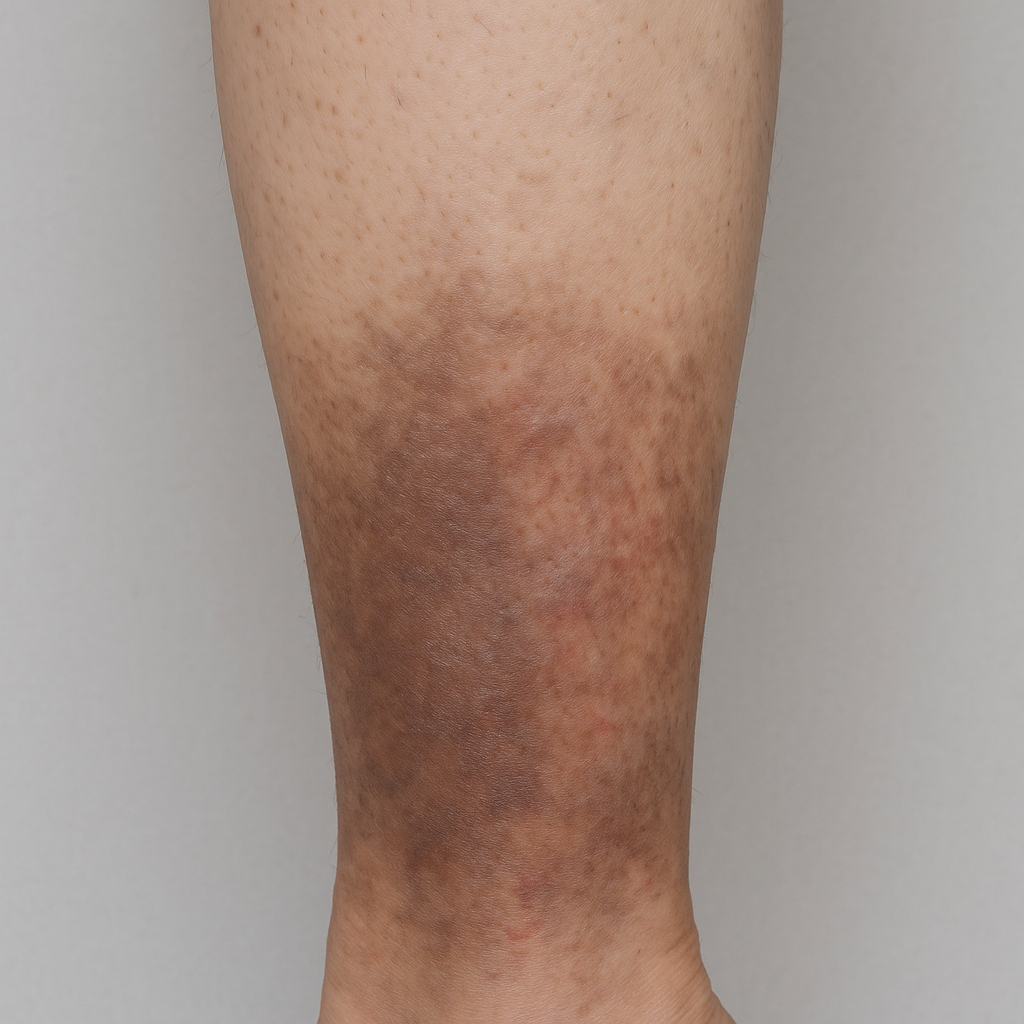Skin Irritation Care in Los Angeles, CA
Skin irritation of the lower legs is a common but often under-recognized sign of underlying venous insufficiency. Many people experience itching, dryness, or redness and assume these changes are minor skin problems. In reality, these symptoms can actually reflect poor vein function. It’s important to seek a diagnosis from a vein care doctor who can properly evaluate unusual skin changes and treat the underlying vein conditions.
At the Vein & Wound Center of LA, phlebologist Dr. Christopher Kim assesses skin changes with a focus on uncovering venous causes and creating plans that support long-term improvement. His background in general surgery and extensive experience in both vein and wound care allow him to identify patterns that are frequently missed in cosmetic settings.
Causes of Skin Irritation on Legs
Skin irritation on the legs is often more than a surface problem. While dry weather or allergens can contribute, persistent irritation may indicate deeper issues involving the veins or lymphatic system.
Venous insufficiency is a common cause, where weakened valves allow blood to pool in the legs, leading to inflammation and skin changes. Varicose veins can also disrupt circulation, causing discomfort and visible skin irritation. Additionally, lymphedema, or fluid buildup from a compromised lymphatic system, often results in swelling and irritated skin. Without treatment, these conditions can progress, increasing the risk of complications like ulcers or infections.
It’s easy to overlook skin discomfort or assume it’s just dryness or a reaction to a new product. However, when skin changes persist—especially on the legs or ankles—they may be linked to deeper venous or lymphatic dysfunction.
Signs That Skin Irritation May Be Vein-Related
- Itching or burning that does not improve with over-the-counter creams
- Dry or flaky skin that returns quickly after moisturizing
- Redness or discoloration, sometimes progressing to brown patches
- Thickened, tight, or firm skin
- Swelling in the legs or ankles
How Circulation Problems Affect the Skin
Chronic venous insufficiency creates sustained pressure in the veins.
Over time, this leads to:
- Leakage of proteins and red blood cells into the surrounding tissue
- Ongoing inflammation that disrupts the skin barrier
- Pigment changes and progressive thickening
These changes often worsen slowly and may be mistaken for routine dryness. Treating the circulation issue is essential to prevent recurrence.
Common Skin Conditions Related to Venous Insufficiency
Venous Eczema (Stasis Dermatitis)

Appearance: Red, itchy, scaly patches around the ankles or lower legs
Cause: Increased venous pressure allows inflammatory cells and fluid to settle in the skin
Symptoms patients may notice:
• Itch that worsens at the end of the day
• Rash that flares around varicose veins
• Scaling or oozing when the skin barrier breaks down
Why it matters:
Long-term inflammation can weaken the skin and increase the chance of ulcer formation.
Clinical insight:
Venous eczema often develops when small surface veins are under too much pressure. When these veins are linked with deeper reflux, treating the faulty veins—sometimes with procedures like sclerotherapy—can help calm inflammation and improve the skin.
Hyperpigmentation

Appearance: Brown or dark skin changes
Cause: Red blood cells breaking down under long-standing venous pressure
Symptoms patients may notice:
• Gradual darkening around the ankles
• Patchy brown or rust-colored spots
Why it matters:
These pigment changes signal ongoing venous hypertension. Improving circulation may slow further darkening, but existing pigment can take time to fade.
Lipodermatosclerosis

Appearance: Tight, firm, or thickened skin
Cause: Chronic inflammation and fibrosis from elevated venous pressure
Symptoms patients may notice:
• Skin that feels firm or “woody”
• Pain or tenderness
• Narrowing of the lower leg above the ankle
Why it matters:
This is an advanced sign of venous disease and increases the risk of ulceration.
Venous Ulcers

Appearance: Open sores near the ankle with inflamed or darkened skin
Cause: Tissue breakdown from long-standing venous insufficiency
Symptoms patients may notice:
• Shallow, irregular wounds
• Surrounding redness or dark patches
• Persistent drainage
Why it matters:
Venous ulcers require care for both the wound and the underlying venous reflux to support healing and reduce recurrence.
Skin Conditions That May Look Similar
It’s important to distinguish venous-related skin irritation from other common conditions, including:
- Atopic dermatitis (eczema): Usually begins earlier in life, often affects flexural surfaces, and may not be limited to the legs.
- Contact dermatitis: Localized rash triggered by allergens or irritants, typically well-demarcated.
- Psoriasis: Red plaques with silvery scale, often involving the knees, elbows, and scalp.
- Cellulitis: Bacterial infection of the skin presenting with acute redness, warmth, swelling, and tenderness; usually unilateral and accompanied by systemic symptoms.
- Lymphedema-related skin changes: Thickened, peau d’orange skin, often with swelling extending into the foot.
Diagnosis and Treatment in Our Los Angeles Clinic
Complete Evaluation
During the diagnostic process, Dr. Kim reviews your symptoms, medical history, and daily habits to determine whether the irritation matches patterns of venous or lymphatic disease.
Venous Ultrasound or Skin Biopsy
When indicated, a venous ultrasound evaluates blood flow, valve function, and signs of reflux. This non-invasive test helps identify circulation problems contributing to skin changes. Sometimes, a skin biopsy may also be needed.
Personalized Treatment
Your plan may include:
- Compression therapy for improved circulation
- Minimally invasive procedures such as endovenous laser therapy (EVLT) or sclerotherapy to treat faulty veins
- Skincare recommendations and medical-grade topical treatments to restore skin integrity
- Medications to reduce inflammation or address underlying conditions
Treating both the visible symptoms and the deeper cause helps prevent recurrence.
Home Care Strategies for Vein-Related Skin Issues
While not a substitute for medical care, some changes to your routine can help improve comfort while supporting skin and vein health:
- Elevate your legs for 15–20 minutes
- Take regular walks or light movement
- Use fragrance-free moisturizer
- Wear compression stockings if recommended
- Avoid long periods of sitting or standing
- Choose breathable, non-irritating clothing
- Limit hot showers and harsh soaps
- Monitor for new discoloration or worsening irritation
When to Seek Medical Care for Leg Irritation
A clinical evaluation is recommended if you notice:
- • Leg irritation lasting more than a few weeks
- • Redness or itch that keeps returning
- • Swelling in the legs or ankles
- • New darkening or firm skin texture
- • Skin breakdown or signs of infection
It’s particularly important to see a vein doctor for skin irritation if you have a history of varicose veins or venous insufficiency and are experiencing worsening discomfort.
Long-Term Outlook
The long-term outlook depends on how early circulation problems are identified. When irritation is addressed promptly and the underlying issue is treated, most people experience improvement in skin comfort, texture, and discoloration. Without treatment, rising venous pressure can lead to thickened skin, chronic inflammation, and ulcer formation. Early evaluation offers the best chance for lasting relief.
Why Choose Vein & Wound Center of LA for Skin Irritation?
- Care Designed for You: Your symptoms, history, and goals guide every decision.
- Precise Diagnosis: We evaluate the skin and the underlying circulation to identify the true cause of irritation.
- Extensive Experience: With thousands of vein procedures performed, Dr. Kim recognizes patterns that may be missed in non-medical settings.
- Minimally Invasive Options: We offer modern, in-office treatments that support both skin and vein health.
- Convenient Koreatown Location: Our clinic provides secure, free garage parking for all visits.
Frequently Asked Questions
Can skin irritation really be caused by my veins?
Yes. When irritation appears mostly on the lower legs or ankles and doesn’t respond to moisturizers, vein disease is often involved.
Who is most at risk of vein-related skin irritation?
Skin irritation from venous disease is more common in people with:
- Family history of vein disease
- Jobs with prolonged standing or sitting
- Prior pregnancies
- Age over 40
- Obesity or reduced mobility
- History of leg injury, surgery, or clots
- Chronic swelling or lymphedema
If I don’t see varicose veins, can it still be venous insufficiency?
Yes. Many people develop reflux in deeper veins before surface veins become visible.
Does treating the veins improve the skin?
Improving circulation often reduces itch, inflammation, and discoloration. The skin typically responds well once venous pressure decreases.
Do I need a biopsy?
A biopsy may be recommended if symptoms resemble dermatologic conditions, but it is not always necessary.
Will creams alone fix the irritation?
Creams may offer temporary relief, but irritation usually returns until circulation is addressed.
Can untreated irritation lead to more serious problems?
Yes. Long-standing venous pressure can lead to thickened skin, hardened tissue, and even venous ulceration—making early diagnosis and treatment important.
How does sclerotherapy help with skin irritation?
If refluxing tributary veins are contributing to venous eczema, sclerotherapy can close these abnormal vessels, reducing inflammation and improving skin health.
References
- Eberhardt RT, Raffetto JD. Chronic venous insufficiency. Circulation. 2014;130(4):333-346.
- Miteva M, Romanelli P, Kirsner RS. Skin changes associated with chronic venous disease. Clin Dermatol. 2008;26(1):44-50.
- Alavi A, et al. Management of venous leg ulcers: Clinical practice guidelines. J Am Acad Dermatol. 2014;70(6):1047-1057.
- Pappas PJ, Lal BK. Pathophysiology of chronic venous disease. J Vasc Surg: Venous and Lymphatic Disorders. 2018;6(5):618-629.

Find Relief from Skin Irritation in Los Angeles, CA
If irritation on your lower legs keeps returning or has begun to worsen, an evaluation may help determine whether vein disease is involved. Call (213) 654-8346 to schedule a consultation with our vein doctor in Koreatown and learn how our team supports healthier skin and improved leg comfort.
